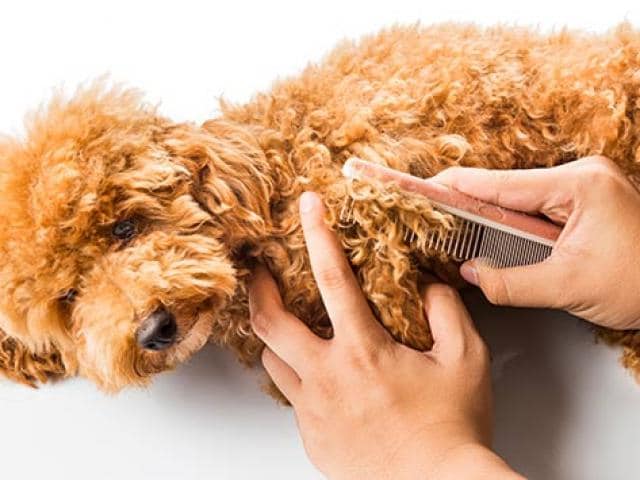Last Updated on February 14, 2024 by Fumipets
Demystifying Matting: Understanding and Tackling Your Dog’s Matted Coat Woes
A dog’s coat is not just an aesthetic feature; it’s a crucial aspect of their overall health and well-being. However, many dog owners find themselves grappling with the challenge of matting—a common issue that can affect dogs of various breeds and coat types.
Matting occurs when the fur becomes tangled and knotted, leading to discomfort for the furry friend and potential health risks. In this comprehensive guide, we will explore the reasons behind your dog’s matting woes and provide practical solutions to keep their coat healthy, shiny, and mat-free.
Your Dog’s Matted Coat
Without regular brushing, dog hair gets twisted and wrapped around itself, a condition known as matting. Many dog breeds with curly, fine, or double coats are prone to mats.
In severe circumstances, the dog’s coat will become “pelted,” which refers to matting that is extremely close to the skin and prevents normal ventilation.
Matting and pelting inhibit normal temperature control, induce skin irritation, conceal parasites such as fleas and other nasties, and give the dog tremendous suffering and anguish.
Mats are mostly avoidable! Let’s take a look at why your dog’s coat is mating and what you can do to prevent them. We’ll also discuss what you may do if your dog’s coat has already become matted.
What Causes Your Dog’s Fur to Mat?
Mats occur when tangled dog hair wraps around itself, generating tightly wrapped clumps of loose dead and living fur. They continue to trap more hair if not brushed off, getting closer and closer to the dog’s skin. Mats often develop in locations where there is a lot of friction, such as around the collar region, behind the ears (where people love to scratch them), under their chin, armpits, under where their harness generally rests, their feet, and on the back of their rear legs.
Matting is particularly common during seasonal shedding periods, when a dog’s coat is “blowing coat” to transition from winter to summer or vice versa. If the loose fur isn’t brushed out, it rubs against the skin and, if left too long, develops matting and pelting. Swimming dogs are more likely to develop mats because the dampness encourages their hair to coil and dry wrapped around themselves. Many dogs get matting after being washed but not completely brushed and dried.
While matting may occur in any dog with a longer or double coat, certain dog breeds are more prone to it than others – just ask any doodle owner. Doodle coats are a cross between a curly and a double coat, making them ideal for matting. Poodles and Bichon Frisés, for example, have curly coats that mat readily if not kept up with. The same may be said for long-coated breeds like Bearded Collies and Rough Coat Collies.

Cords vs. Mats
A few dog breeds have coats that are supposed to be “corded” — that is, their coats are rigorously combed by hand to resemble dreadlocks or cords. This may seem to be matting, but it’s intended to be cut and maintained to avoid skin problems..
The Puli, Komondor, and Bergamasco Shepherd are the most frequent breeds with corded coats. Many people affectionately refer to these canines as “mop dogs.” While guarding and herding animals, keeping their coat in this state helps them blend in.
You could even see a corded coat on a Poodle or Havanese for aesthetic and show reasons. Cording is not for the average dog owner since it necessitates a lot of upkeep and an educated touch when it comes to making the cords and avoiding matting below.
How to Prevent Your Dog’s Fur From Matting
Brush your dog’s coat on a regular basis.
Regular and thorough combing and brushing is the most effective way to avoid matting in your dog’s coat. Brushing your dog depends on their coat type and whether or not it’s “shedding season” (when their coats change from a thinner summer coat to a thicker winter coat or vice versa). Long coats, curly coats, and fine fur breeds should be brushed more often, even daily in certain situations, but other coat types may only need brushing once a week.
When brushing a dog’s hair, one of the most frequent blunders is merely combing the top layer, which may exacerbate matting. Brushing simply the top layer of your dog’s hair actually pushes any loose fur and knots closer to the skin. You may prevent this by brushing your dog with the appropriate brush for his hair type, such as an undercoat rake if he has a double coat or a revolving pin comb or slicker brush if he has a single layer curly coat.
Brushing your dog will be simpler if you use a detangling leave-in conditioning spray, particularly if your dog has a long coat that tangles easily. After a wash, spray the leave-in conditioner on your dog’s moist coat before drying it, or softly spritz dry fur and brush it through their hair.

Remove Your Dog’s Harness When Not In Use and Use a Rolled Leather Collar
Mats often develop behind your dog’s collar or where their walking harness hangs on their chest and armpits. When they’re not on a leash, take off their harness. To avoid knots around their neck, use a curled leather collar instead of a flat collar.
Schedule regular grooming sessions with your professional groomer
To avoid matting, several breeds and breed mixtures, such as Poodles, Doodle-mixes, Coton de Tulear, and Bichon Frisés, need significant coat upkeep. Their delicate hair becomes matted extremely rapidly, even with frequent at-home combing, particularly when wet.
Even frequent use of an ear cleaning solution might provide enough moisture to mat the hair around their ears (like in the photo below). To avoid matting, schedule a professional brush-out service with your groomer in between full grooming sessions, or ask for a half grooming appointment (such as a Feet, Face, and Fanny service, or Beach Clip service).
These care treatments, along with frequent brushing to avoid matting, are vital if you want to keep your dog’s hair long. If you have a dog with a high-maintenance coat, we suggest coming to the groomer for a thorough groom and haircut every 6 to 8 weeks to maintain their coat in tip-top form.
Regular brushing and maintenance sessions at home ensure that your dog has a better experience at the groomer during their “spaw” treatments. Even when performed by a professional, mat removal may be an unpleasant experience for your dog, and you don’t want your dog to associate grooming with a painful brush out or complete shave.
Keep your dog’s fur as short as possible.
Another way to avoid matting is to maintain your dog’s coat short and slick, which makes brushing simpler. You’ll have to take them to the groomer more often if you want this method.
Only dogs with single-layer coats should be shaved; double-coated breeds or breed mixtures (Siberian Huskies, Labrador Retrievers, Golden Retrievers, Rottweilers, Corgis, and so on) should not be shaved unless your doctor recommends it for medical reasons.
Many dog owners believe that shaving their double-coated breed’s coat helps keep them cooler in the heat, however cutting their outer coat down has the opposite effect! Shaving a dog’s coat exposes his or her skin, putting them in danger of sunburn and skin cancer. Their outer coat serves as both a temperature regulator and a sun shield. A thorough brushing to get rid of any loose undercoat hair is the best approach to keep your double-coated dog cool instead of shaving.
What Should You Do If Your Dog’s Coat Is Matted?
There are a few things you may do if you find a mat or region of matting when brushing your dog, depending on the severity of the mat.

Is it better to brush or cut off mats?
You may use a comb or slicker brush to pick at the mat, but this can be quite uncomfortable for your dog. You know what I’m talking about if you’ve ever had someone attempt to brush out a knot in your hair on your head!
Brushing isn’t the greatest solution unless the mat is extremely thin and loose. Not only may it be very unpleasant and traumatic for your dog, but it can also lead to a poor brushing experience, souring any future brushing efforts.
If brushing out a mat, apply a tiny quantity of detangling conditioner spray on it and use your fingers to loosen it up a little.
Grab a slicker brush or grooming comb after you’ve separated the mat from the surrounding fur by hand.
With one hand, firmly grip the mat’s base to prevent the brushing from causing discomfort to your dog’s skin.
Rather than brushing from your dog’s skin outwards, begin working on the mat at the farthest spot from the skin.
Brush with very short strokes, take numerous pauses, and reward your dog with some tasty goodies!
If you’re thinking of cutting out the mat at home with scissors, put them down! If you’re cutting off mats with scissors, make sure you’re properly trained, have the right grooming scissors, are comfortable doing it, and have some blood-clotting powder on hand.
When you use scissors instead of clippers to remove matting, your dog is more likely to be injured. You should never pull the mat away from the skin and then cut below it, as this might result in their stretched skin being snipped off as well. If this occurs, you’ll need to see a veterinarian for treatment and anti-infection medicine (which may be expensive), and your dog will be less inclined to be touched in the future.
Shave Out Mats with Grooming Clippers
To shave off the mat, use grooming clippers instead of scissors. The cordless Bravura Lithium clipper from Wahl is our favorite for mat cutting (and paw pad care). The battery lasts a long time, the 5-in-1 blade allows for various trimming lengths, and the lack of a cable makes at-home trimming simple and convenient.
Trim out the matting without pulling or raising the skin. Hold the end of the mat firmly with your fingers and work on the mat with the clippers from the base outwards, peeling it off in sections with the blade to assist avoid visible shaved patches in their coat.
This method only works for isolated mats, such as those behind the ears; if your dog has extensive matting over their body, it’s preferable to take them to a groomer for a full-body trim rather than attempting to remove them yourself.
In the instance of extensive matting, your best choice could be to schedule a sedated clipping with your veterinarian. This may save your dog a lot of pain, suffering, and mental damage while also making the procedure safer for everyone involved.

Mats: What Groomers Can (and Can’t) Do
Professional groomers will not shave your dog any shorter than what is desired or required. Matting makes their work more difficult since it limits the length of the dog’s coat they can trim because they must snip below the mats. If there is pelting on the hair, the haircut will be quite short. This may be distressing for pet owners who want a longer haircut when they pick up their dog from the grooming establishment, but the groomer may not have any other options.
There are a few things you can do to keep yourself from being frustrated. Choose a respected dog groomer with whom you feel at ease and who knows your grooming preferences. When you send your dog in for their appointment, spend a few minutes with them to discuss your preferences. Before you depart, have them check your dog’s body for matting. If they discover any problems, you will have the chance to discuss your options.
You have a few alternatives for matting that you may explore with your groomer:
Shave the matted regions shorter while keeping the remainder of the coat at the correct length – although they will attempt to blend these shorter parts in, it will frequently be evident. It’s simpler to achieve this if the mats are just used on particular parts of the body, such as the belly or inner legs.
To get rid of the matting, shave all over at the shortest length possible. If the mats have knotted near to the skin, this haircut might be rather short, but it is even and won’t seem as patchy.
Overall, frequent brushing and coat upkeep are the greatest ways to prevent mats from developing (including keeping your pets on safe and effective medications to prevent fleas and other parasites from their coat). Make sure you’ve found a reputable dog groomer who can provide you with advice on how to manage your dog’s hair and keep him well-coiffed, happy, and healthy.
Q&A: Addressing the Why and How of Dog Coat Matting
Why does my dog’s coat get matted?
Matting can occur for various reasons, including inadequate grooming, lack of regular brushing, certain medical conditions affecting the coat, and the specific texture of the dog’s fur. Dogs with long, curly, or dense coats are more prone to matting.
Are certain dog breeds more susceptible to matting?
Yes, breeds with long, curly, or thick coats, such as Poodles, Shih Tzus, and Golden Retrievers, are more susceptible to matting. However, matting can occur in any breed, especially if grooming needs are neglected.
How can I prevent matting in my dog’s coat?
Regular grooming and brushing are key preventive measures. Depending on the breed, daily to weekly brushing helps remove loose fur, prevents tangles, and maintains a healthy coat. Using appropriate grooming tools and seeking professional grooming when needed are also crucial.
What health issues can be associated with severe matting?
Severe matting can lead to skin irritation, inflammation, and even infections. Matting can also hide underlying skin issues or parasites, making early detection challenging. Regular grooming not only prevents matting but also allows for the identification of any skin abnormalities.
How should I address existing mats in my dog’s coat?
Gently work through mats with a slicker brush or a mat splitter, starting from the outer edges and working inward. For stubborn mats, consider using detangling sprays or seeking professional grooming assistance. It’s essential to be patient and avoid causing discomfort to your dog during the process.


















